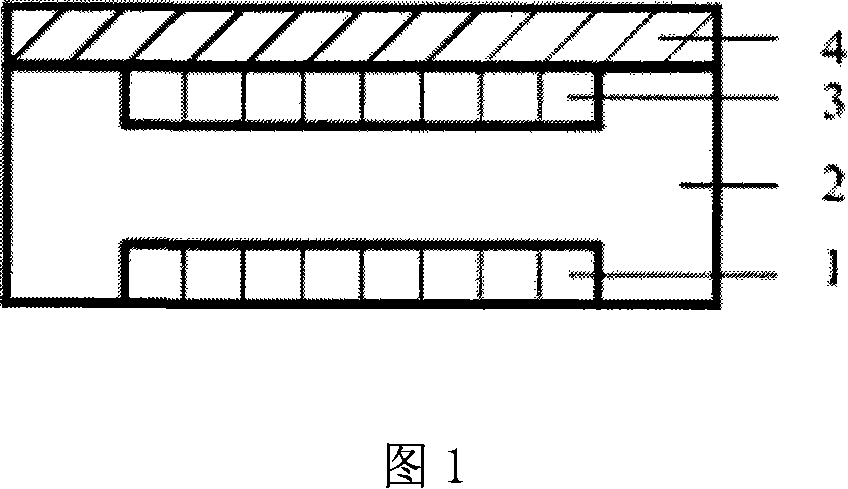Integrated preparing method for molten carbonate fuel cell electrolyte membrane
A technology of molten carbonate and electrolyte membrane, applied in molten electrolyte fuel cells, fuel cell parts, electrolyte holding devices, etc., can solve problems such as troubles, reduce engineering difficulty, reduce manufacturing costs, and shorten manufacturing time Effect
- Summary
- Abstract
- Description
- Claims
- Application Information
AI Technical Summary
Problems solved by technology
Method used
Image
Examples
Embodiment 1
[0019] Take 0.01~0.3μm α-LiAlO 2 100 grams of powder, add 800 grams of secondary water, after ball milling for 24 hours, add Li with a molar ratio of 62 / 38 2 CO 3 / K 2 CO 3 100 grams of electrolyte salt, after ball milling for 2 hours, add 10 grams of Al 2 o 3 After the fiber, continue ball milling for 1 hour, and use it as a slurry for later use.
[0020]As shown in Figure 1, the anode 1 and the cathode 3 are respectively embedded in the grooves of the bipolar plate 2, and the anode 1 and the bipolar plate 2 and the cathode 3 and the bipolar plate 2 respectively constitute two planes up and down. Using the tape-casting method, it is coated on a plane formed by the anode 1 and the bipolar plate 2 to form the electrolyte membrane 4 of the molten carbonate fuel cell. After natural drying at room temperature, it can be directly used for molten carbon salt fuel cell. The electrolyte membrane has a thickness of 0.5 mm, an average pore diameter of 0.3 μm, and an average poros...
Embodiment 2
[0024] Take γ-LiAlO of 0.01~0.3μm 2 100 grams of powder, add 800 grams of secondary water, after ball milling for 12 hours, add Li with a molar ratio of 70 / 30 2 CO 3 / Na 2 CO 3 150 grams of electrolyte salt, after ball milling for 4 hours, add 15 grams of Al 2 o 3 After the fiber, continue ball milling for 2 hours and use it as a slurry for later use.
[0025] The above-mentioned slurry is coated on a plane formed by the anode 1 and the bipolar plate 2 by powder spraying method to form the electrolyte membrane 4 of the molten carbonate fuel cell. After natural drying at room temperature, it can be directly used in molten carbonate fuel cells. The electrolyte membrane has a thickness of 1 mm, an average pore diameter of 0.4 μm, and an average porosity of 60%.
Embodiment 3
[0027] Take 0.01~0.3μm α-LiAlO 2 100 grams of powder, add 500 grams of secondary water, after ball milling for 18 hours, add Li with a molar ratio of 70 / 30 2 CO 3 / Na 2 CO 3 125 grams of electrolyte salt, after ball milling for 3 hours, add 12.5 grams of Al 2 o 3 After the fiber, continue ball milling for 1.5 hours, then use it as a slurry for later use.
[0028] The above-mentioned slurry is coated on a plane formed by the anode 1 and the bipolar plate 2 by tape-casting to form the electrolyte membrane 4 of the molten carbonate fuel cell. After natural drying at room temperature, it can be directly For molten carbonate fuel cells. The electrolyte membrane has a thickness of 0.7 mm, an average pore diameter of 0.35 μm, and an average porosity of 55%. .
[0029] Stacking the components obtained in Example 3 including the cathode, bipolar plate, anode and electrolyte from bottom to top constitutes the electric stack of the molten carbonate fuel cell. Air and carbon diox...
PUM
| Property | Measurement | Unit |
|---|---|---|
| Thickness | aaaaa | aaaaa |
| Average pore size | aaaaa | aaaaa |
| Thickness | aaaaa | aaaaa |
Abstract
Description
Claims
Application Information
 Login to View More
Login to View More - R&D
- Intellectual Property
- Life Sciences
- Materials
- Tech Scout
- Unparalleled Data Quality
- Higher Quality Content
- 60% Fewer Hallucinations
Browse by: Latest US Patents, China's latest patents, Technical Efficacy Thesaurus, Application Domain, Technology Topic, Popular Technical Reports.
© 2025 PatSnap. All rights reserved.Legal|Privacy policy|Modern Slavery Act Transparency Statement|Sitemap|About US| Contact US: help@patsnap.com

